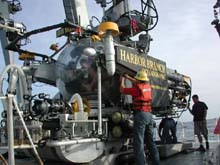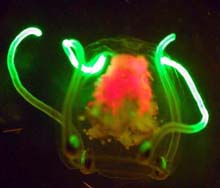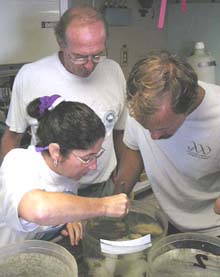
The Johnson-Sea-Link II is launched off the stern of the R/V Seward Johnson. Click image for a larger view.
Where Coral Castles Climb and Soar
August 19, 2002
Paula Keener-ChavisNational Education Coordinator
NOAA Office of Ocean Exploration
![]() Watch video footage of the Johnson-Sea-Link II sampling benthic invertebrates. (mp4, 1.3 MB).
Watch video footage of the Johnson-Sea-Link II sampling benthic invertebrates. (mp4, 1.3 MB).
Beyond the ken of mortal men, beneath the wind and waves,
There lies a land of shells and sand, of chasms, crags and caves
Where coral castles climb and soar, where swaying seaweeds grow,
And all around without a sound the ocean currents flow.
--Graeme Base, The Sign of the Seahorse
The science team gathered at 8:00a.m. in the galley to brief everyone on the results of five hours of fathometer transect work conducted at Site 1 last night. A series of pinnacles, some 200 feet high, run along a northeast/southwest orientation. Several depressions, some as deep as 200 feet, were also found in the area -- something no one expected. The plan is to place the Johnson-Sea-Link II behind the first pinnacle and explore the area for the first time ever. Submersible pilots Craig Caddigan and Alan Fuller join scientists Shirley Pomponi and Edie Widder in the submersible. This is the first time that Pomponi and Widder have ever joined together to conduct exploratory research on an interdisciplinary expedition, although both are scientists at HBOI. By 8:22a.m., the submersible is in the water and 37 minutes later, the crew radios back to the R/V Seward Johnson that they are on the bottom at a depth of 2,095 feet, cruising along a deep ridge.
Scientists hypothesize that the huge eyes of deep-sea benthic creatures are adapted for viewing bioluminescence. But little is known about bioluminescence on the deep-sea floor, and we know virtually nothing about the visual systems of these deep-sea inhabitants.

An unidentified jellyfish collected in the morning from a small net deployed over the side of the vessel. Click image for a larger view.
Four hours later, in what remains of a brief squall complete with 40 kt winds and two waterspout sightings, the submersible is retrieved from the water. Chief Scientist Pomponi emerges from the hatch with a smile on her face. Acrylic sampling containers are quickly carried to the wet lab with glass sponges, gorgonian corals, soft corals, hard corals, hydroids, brittle stars, sea stars, and other invertebrates that display a wide variety of colors beige, off-white, pale yellow, peach, brown, bright orange, and mustard yellow.
Scientists all become eager onlookers as they surround the table in the wet lab peering into a dozen 5-gallon clear acrylic containers that hold the deep-sea organisms collected with the hope of pharmaceutical potential. Voucher samples are collected for identification purposes and more samples are collected for molecular research. Pomponi reports that they spent most of their time collecting samples on one ridge with a relief of about 30 feet. "It was loaded with corals, absolutely loaded," she says.

Scientists gather to look at the many samples collected during the submersible's dive. Click image for a larger view.
As it nears late afternoon, the battery for the Johnson-Sea-Link II's second dive is charged and the basket is loaded with Tammy Frank's baited light-tight traps and Edie Widder's Eye-in-the-Sea camera. This is the first time that either of these two sampling technologies has ever been used. Don Liberatore gives a dive briefing stating, "the target dive area is flat enough to deploy the camera and the traps. We need to verify that the pingers are working, then collect our data and more samples. That's it. Let's go load up." The submersible is in the water by 5:10p.m. carrying Widder, Frank, Caddigan, and Fuller to the bottom of the ocean. Back in the lab, Pomponi peers in a microscope as she examines spicules from a sponge collected earlier today with hopes of determining its identification.
Sign up for the Ocean Explorer E-mail Update List.














































